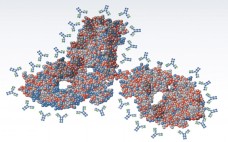When we launched the BioProcess Theater series at the Biotechnology Industry Organization’s International Convention in 2007, we hoped that our special programming would fill a need within that event’s exhibit hall. We wanted to bring into the hall the type of technical presentations that are not generally part of the main event’s more executive-level, business-focused programming.It has therefore been especially gratifying to see our attendance growing every year — such that standing-room-only is becoming more the rule than the exception.…
Search Results for: antibody characterization
Targeting G Protein–Coupled Receptors with Biologics for Therapeutic Use, Part 2
In part 1, we summarized the advances made in new approaches developed to address the challenges of antigen generation for targeting G protein–coupled receptors (GPCRs). We reviewed the antibody and biologics pipeline with progress highlighted by some interesting case studies on new targets (1). Here, we conclude by reviewing progress attained with other biologics. Peptides Targeting G Protein–Coupled Receptors More than 50 peptide-based therapeutic products are commercially available, but very few of them have been derived from recombinant display technology.…
Biopharmaceutical Product Development: Helping to Develop Better Biologic Products, Faster
From drug and biologic development services to delivery technologies to supply solutions, we are the catalyst for your success. With over 80 years of experience, we have the deepest expertise, broadest offerings, and the most innovative technologies to help you get more molecules to market faster, enhance product performance, and provide superior, reliable manufacturing and improved results. Catalent is your strategic partner for biologic drug development success. SMARTag™ ADC Technology for the Development of Optimized Antibody–Drug Conjugates: Catalent has an…
Reducing the Host Cell DNA Quantitation Bottleneck: Approaches for Improved Sample Preparation and Throughput
The removal of impurities arising from host cells used for the production of biopharmaceutical products is a crucial step in the purification process. Regulatory guidance for products produced in cell culture specifies that residual host cell DNA content in the final product should be as low as possible. Because of the low sample throughput typical of most quantitative DNA assays, host-cell DNA quantitation can become an analytical bottleneck during process characterization.
In this webcast, speakers will discuss a qPCR-based system for highly sensitive, accurate quantitation of residual host-cell DNA from a variety of cellular production systems, including Chinese Hamster Ovary (CHO), E. coli and Vero cells. Case studies will be presented that demonstrate DNA recovery from highly complex test sample matrices, typical of those in biopharmaceutical manufacturing environments. Options for automated sample preparation, testing results from samples typical of a monoclonal antibody purification process and results from an external validation study, executed according to ICH guidelines, will also be reviewed.
Higher-Order Structure Comparability: Case Studies of Biosimilar Monoclonal Antibodies
Great successes for monoclonal antibody (MAb)–based biologics over the past decade have provided many valuable options for patients combating some of the most serious diseases in the world, including cancer and autoimmune diseases. MAbs and antibody–drug conjugates (ADCs) are among the fastest growing biologic segments in development, with hundreds of candidates currently under clinical study. Meanwhile, society is facing the challenge of increasingly higher costs in healthcare including the cost of pharmaceuticals. With an aging population in many parts of…
Biosimilars Awaken CROs
Biosimilars are revolutionizing the bioprocessing industry. Over the years, company CEOs have pushed different models, expanding and closing down huge amounts of internal manufacturing, research and development, and quality control facilities. Sometimes services were pushed to Asia, only to get brought back a few years afterward when a new CEO was appointed. Mergers and acquisitions further complicated those ideas. Consequently, many biopharmaceutical companies now have “gaps” in their drug development service provisions. Filling those gaps will fall on contract research…
Qualification of Scale-Down Bioreactors: Validation of Process Changes in Commercial Production of Animal-Cell-Derived Products, Part 1 — Concept
Implementing continuous process improvements is increasing in priority for the biopharmaceutical industry. Such implementation can be driven by product safety, purity, and stability enhancement opportunities as well as by cost-reduction pressures. Companies invest in projects to improve product quality assurance, safety, and yield as well as production efficiency (1). Such changes may come at any process stage, from early cell-growth methods through final-product packaging improvements. Examples include growth medium optimization, purification column operation optimization, and enhanced recovery during final filling…
Highly Concentrated Protein Formulations: Finding Solutions for the Next Generation of Parenteral Biologics
Therapeutic protein formulation is no easy task. Biological drugs may be destined for prefilled syringes or glass vials, or they may be made into lyophilized powders that will be reconstituted in a clinical setting. No matter what their final state will be, recombinant proteins must remain potent and efficacious during storage. In recent years, pharmaceutical companies have turned increasingly to high-concentration protein formulations. Such drug formulations can offer patients the convenience of self-injection — instead of a trip to the…
Rapid Generation of Stable NS0 Production Cell Lines in Chemically Defined Medium
In 1982, authentic human insulin produced in genetically engineered Escherichia coli (under the trade name Humulin, from Genentech) was the first recombinant protein to be licensed by regulatory authorities for therapeutic use. That licensure and the subsequent production of human growth hormone heralded a new era of biopharmaceuticals and were the first examples of the industry's future potential. Both proteins are produced as fully active biologicals in E. coli. Insulin and human growth hormone are fairly simple small proteins, without…
High–Cell-Density Clarification By Single-Use Diatomaceous Earth Filtration
Single-use concepts are widespread in all unit operations of the biopharmaceutical industry. Although single-use technology is rapidly advancing and considered to be highly advantageous in many regards (1,2,3), in some cases it cannot (yet) compete with classical manufacturing systems. Processes with a demanding character (e.g., high cell densities, high titers, high turbidities, increased particle/contaminant loads) especially can bring disposables to their limit of technical feasibility, especially in product harvesting (4,5,6). Here we focus on that step, which is defined as…






